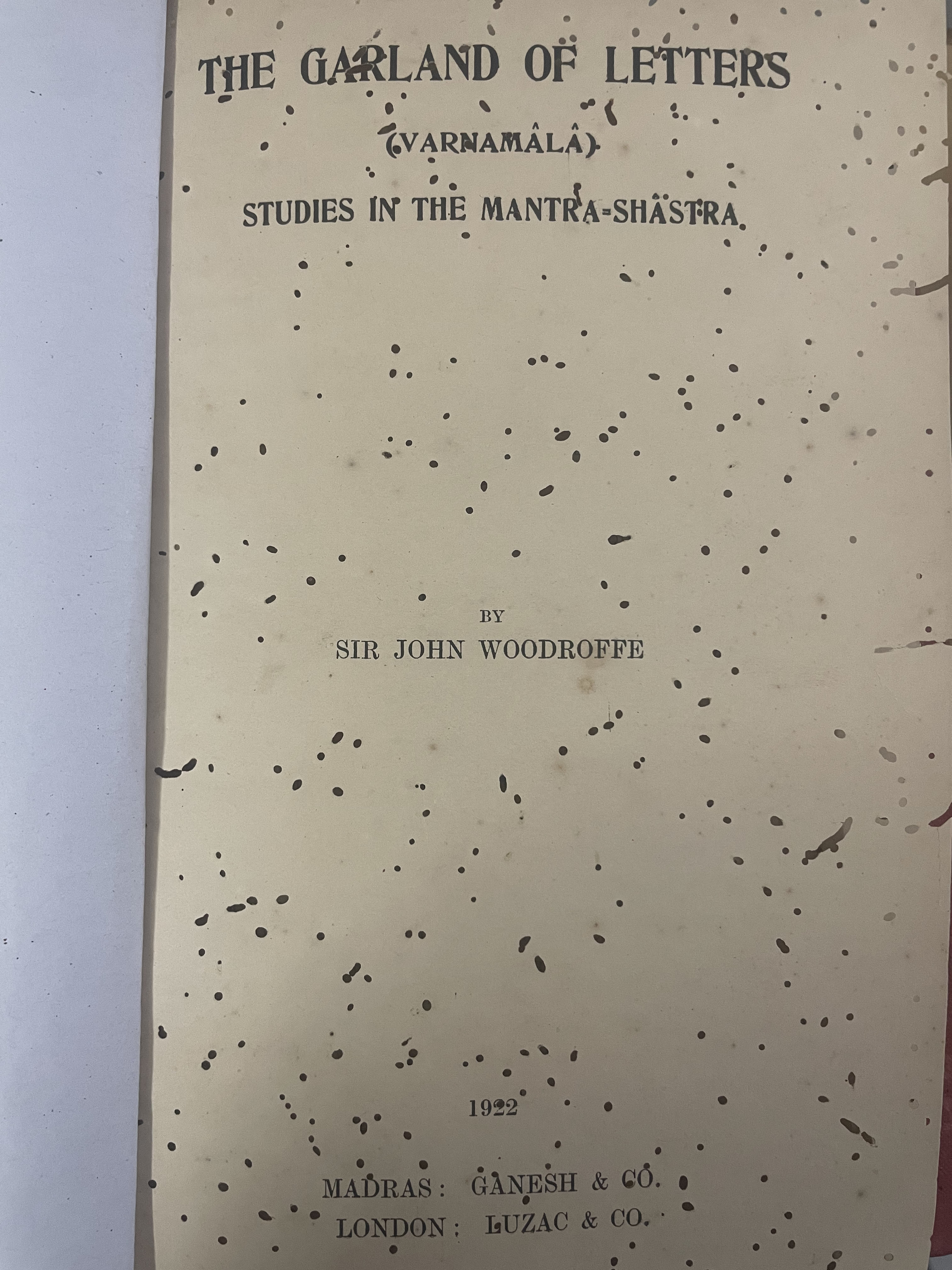The Garland of LettersStudies in the Mantra Shastra

About
Summary
Exquisite
TOC
Details
Related
URL
Images
Overview
The Garland of Letters: Studies in the Mantra Shastra by Sir John Woodroffe, also known as Arthur Avalon, is a detailed exploration of Tantra and Mantra Shastra, focusing on the significance of Sanskrit phonetics and the philosophies within Tantric practices. Woodroffe's work aims to demystify Tantra, presenting its core principles, rituals, and spiritual significance in a way that is accessible to both novices and experienced spiritual seekers.Woodroffe, an expert in Indian jurisprudence and philosophy, delves into the mystical dimensions of Tantra, explaining the esoteric meanings of the Sanskrit alphabet and how each letter forms the universe's cosmic vibration. The book emphasizes the interconnectedness of sound, form, and consciousness, offering a deeper understanding of the sacred Tantric tradition. It explores the power of mantras, the intricacies of Sanskrit phonetics, and the deep philosophies inherent in Tantric practices.
Importance of Book
Demystification of Tantra: The book clarifies Tantra's complex philosophies and practices, making them understandable to a wider audience.
Exploration of Mantra Shastra: It provides a close study of Mantra Shastra, revealing valuable elements to those with a metaphysical bent of mind.
Interconnectedness of Concepts: The book illuminates the relationship between sound, form, and consciousness.
Accessibility: Woodroffe's writing makes ancient knowledge accessible to both beginners and seasoned spiritual seekers.
Key Themes
The Garland of Letters (Varṇamālā): The string of heads in the garland represents the fifty or fifty-one letters of the Sanskrit alphabet, symbolizing the universe of names and forms. These letters embody Speech (Śabda) and its meaning or object (Artha).
The Power of Letters: The letters represent the universe of names and forms and are worn by the Creatrix and Dissolving Power, symbolizing the withdrawal of the world into undivided consciousness.
Mantra and Consciousness: The book delves into the relationship between mantras and consciousness, explaining how mantras can transform personal spiritual practice.
Tantric Rituals: Woodroffe explains the symbolic and practical aspects of Tantric rituals.
Core Concepts of Tantra: Detailed explanations of key concepts such as chakras, mantras, and yantras are provided.
Kundalini Yoga: Woodroffe's work also touches on Kundalini yoga, which he introduced to the West. The movements of projection are indicated by the subtle and gross letters that exist on the petals of the inner bodily centers or lotuses.
Cultural Significance
Preservation of Tradition: The book helps preserve and promote the understanding of Tantra, a significant aspect of Indian spiritual heritage.
Reinterpretation of Tantra: Woodroffe's work was instrumental in turning the image of Tantra from a misunderstood practice into a refined spiritual philosophy, enhancing Hinduism's appeal to Westerners.
Bridge Between East and West: Woodroffe's efforts bridged Eastern spiritual traditions and Western understanding, making complex concepts accessible to a global audience.
Scholarly Contribution: His books are considered classics, offering excellent knowledge on the often difficult-to-interpret subject of Tantra Shastra.
Effects on Society
Influence on Western Spirituality: Woodroffe introduced Kundalini yoga to the West and made Tantra more acceptable and fashionable.
Enhanced Understanding of Indian Philosophy: His translations and interpretations of sacred Hindu texts provided deeper insights into Indian philosophical traditions for Westerners.
Promotion of Indian Culture: Woodroffe's work helped to counter the misunderstanding and misrepresentation of Indian doctrines and practices by foreigners.
Support for Indian Nationalism: Woodroffe, like Annie Besant and others, supported Indian nationalism, contributing to a positive view of Indian culture and spirituality.
Educational Resource: The book serves as an essential resource for students of Eastern thought, practitioners of Yoga and Tantra, and anyone interested in spiritual knowledge.
Conclusion
The Garland of Letters by Sir John Woodroffe is a comprehensive exploration of Tantra and Mantra Shastra, providing deep insights into the mystical and philosophical dimensions of these traditions. Its cultural significance lies in its role in reinterpreting Tantra, bridging Eastern and Western understanding, and promoting a deeper appreciation of Indian spiritual heritage. The book's impact is evident in its influence on Western spirituality, its contribution to a more nuanced understanding of Indian philosophy, and its enduring value as an educational resource.
Table of Content
The 1922 edition of The Garland of Letters: Studies in the Mantra Shastra by Sir John Woodroffe is a detailed examination of the Mantra Shastra within Tantric traditions. While I do not have access to the specific table of contents for this edition, a general outline based on the book\'s subject matter and Sir John Woodroffe\'s approach can be provided:Table of Contents
IntroductionOverview of the study\'s scope and objectives.
Explanation of the importance of Mantra Shastra in Tantric practices.
The Concept of MantraDefinition and significance of mantras in Hindu philosophy.
The role of sound and vibration in spiritual practices.
Sanskrit Letters and Their Esoteric MeaningsDetailed analysis of the Sanskrit alphabet and its symbolic significance.
Examination of each letter (Akshara) and its mystical properties.
The Structure of MantrasExplanation of the components and structure of mantras.
How mantras are formed and their phonetic aspects.
Mantra and the CosmosThe relationship between mantras and cosmic principles.
Understanding the vibrational impact of mantras on the material and spiritual worlds.
Tantric Philosophy and MantrasIntegration of mantras within Tantric rituals and practices.
Theological and philosophical context of mantras in Tantric texts.
Ritualistic Use of MantrasApplication of mantras in various rituals and ceremonies.
The effectiveness and purpose of mantras in Tantric rituals.
Historical PerspectivesHistorical development of mantra practices.
Influence of ancient texts and traditions on contemporary Mantra Shastra.
Theoretical FoundationsPhilosophical underpinnings of Mantra Shastra.
Discussion on the theoretical aspects of mantra efficacy and usage.
Practical ApplicationsGuidelines for the practical use of mantras in meditation and spiritual exercises.
Instructions for performing mantra-based rituals.
Title
The Garland of LettersStudies in the Mantra Shastra
Author
Sir John Woodroffe
Name of Publisher
M R Ramaseahiar of Ganesh Co Madras
Publish Date
1922
Subject
The Mantra Shastra
Vintage
1901-1947
Number of Pages
294
Category
Religion/Spirituality
Sub Category
Hindu Studies
Rarity
RARE
